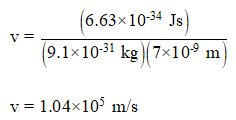To resolve an object in an electron microscope, the wavelength of the electrons must be close to the diameter of the object. What kinetic energy must the electrons have in order to resolve a protein molecule that is 7.00 nm in diameter? Take the mass of an electron to be kg.
Quantum mechanics and hydrogen atom
Consider an electron of mass m moves with the velocity v in a hydrogen atom. If an electron is at a distance r from the proton, then the potential energy function of the electron can be written as follows:
Isotopes of Hydrogen Atoms
To understand isotopes, it's easiest to learn the simplest system. Hydrogen, the most basic nucleus, has received a great deal of attention. Several of the results seen in more complex nuclei can be seen in hydrogen isotopes. An isotope is a nucleus of the same atomic number (Z) but a different atomic mass number (A). The number of neutrons present in the nucleus varies with respect to the isotope.
Mass of Hydrogen Atom
Hydrogen is one of the most fundamental elements on Earth which is colorless, odorless, and a flammable chemical substance. The representation of hydrogen in the periodic table is H. It is mostly found as a diatomic molecule as water H2O on earth. It is also known to be the lightest element and takes its place on Earth up to 0.14 %. There are three isotopes of hydrogen- protium, deuterium, and tritium. There is a huge abundance of Hydrogen molecules on the earth's surface. The hydrogen isotope tritium has its half-life equal to 12.32 years, through beta decay. In physics, the study of Hydrogen is fundamental.
To resolve an object in an electron microscope, the wavelength of the electrons must be close to the diameter of the object. What kinetic energy must the electrons have in order to resolve a protein molecule that is 7.00 nm in diameter? Take the mass of an electron to be kg.
To resolve an object in an electron microscope, the wavelength of the electrons must be close to the diameter of the object.
Diameter of the protein molecule = 7 nm =7×10-9m
Therefore the wavelength of electron λ=7×10-9m

Where v is the velocity of electron
m = 9.1×10-31 kg is the mass of electron
h = 6.63×10-34 Js is the Plank's constant
The velocity of electron is

Step by step
Solved in 4 steps with 3 images









